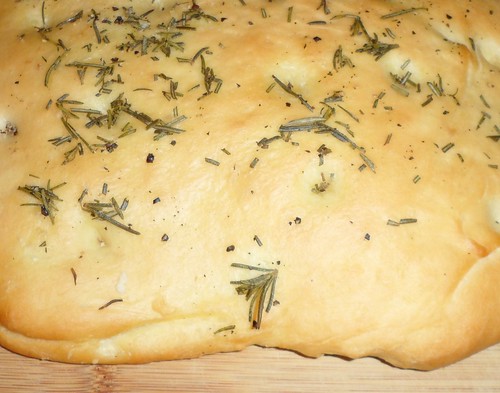I try to avoid using the oven during the summer. Now that the weather has turned cool, it is a perfect time to bake focaccia.
Before my kids went away to college, we would enjoy this as an appetizer on home trivia evenings. We used the Brain Quest trivia decks when my son and daughter were young. The kids always liked it when they could answer a question based on something they learned in school. It was even better if they knew something their parents did not.
My kids liked to take focaccia sandwiches to school for lunch. I enjoy the bread reheated until crunchy and served with soup on cold day.
This recipe is based on the "Rosemary Focaccia" recipe in Betty Crocker's Bread Machine Cookbook (copyright 1995) that my sister gave me. I doubled the recipe quantities and modified the recipe to use a free-standing KithenAid mixer instead of a bread machine.
RosemarySince we have a hugh rosemary bush growing in the front of our house, I use fresh rosemary. Rosemary is easy to grow; just remember that rosemary likes dry soil. Our family still talks about the rosemary and lavender hedges we saw in Australia.
If you use dried rosemary, soak the rosemary in olive oil before spreading on top.
VariationsThis recipe is easy to modify. I have used jalapeño slices, olives, Parmesan cheese, and cooked potato slices as toppings. I have also added crushed red pepper flakes and Indian 5 Spice mixture (i.e., equal parts of cumin seeds, black mustard seeds, fennel seeds, fenugreek seeds, and kalonji seeds) to the dough.
YeastI use bulk yeast, currently Fleischmann's Instant Dry Yeast, that I buy at Sam's.
Baking sheetsMy baking sheets are seasoned and I do not grease them. If needed, grease baking sheets before placing loaves on them.
Olive oilI find the easiest way to spread the olive oil on top of dough is with my fingers. You can use a pastry brush or slowly pour the oil from the bottle instead.
Ingredients| 1 1/2 | Cups | Warm water |
| 1 | Tbsp | Yeast |
| pinch | Sugar, for yeast liquid | |
| 4 | Cups | Bread flour |
| 2 | Tbsp | Sugar, for dough |
| 1 | Tbsp | Salt |
| 4 | Tbsp | Olive oil for dough |
| 4 | Tbsp | Olive oil for topping |
| 4 | Tbsp | Rosemary, fresh preferred, chopped |
| Fresh ground black pepper, to taste | ||
| Kosher flake salt, optional |
- In small pitcher or pyrex measuring cup, mix lukewarm water, yeast, and pinch sugar. Let sit 5-10 minutes until yeast starts working, liquid gets frothy as bubbles begin to form.
- While waiting, put bread flour, sugar, salt, and olive oil in KitchenAid mixing bowl.
- Using flat beater at low speed, mix yeast liquid into flour mixture until just moist. Cover with a towel, and wait 5 minutes.
- Switch to dough hook, and mix for about 5 minutes until dough is smooth and elastic and forms a ball. If dough is too sticky, add 1-2 tablespoon flour at a time, and continue mixing and adding flour until dough is correct consistency.
- Place dough in oiled bowl, and turn dough to coat with oil. Cover bowl with a towel, and let rise until double, about 1 hour.
- Divide dough into 2 pieces. Using a rolling pin, roll each piece into a rectangle, approximately 10" X 12". If needed, grease baking sheets. Place each dough rectangle on a baking sheet. Cover with towels, and let rise about 30 minutes.
- Preheat oven to 400 degrees.
- Using your finger, make indentations in dough about every 2". Top each loaf with olive oil, rosemary, and freshly ground black pepper. If desired, sprinkle kosher flake salt on top.
- Bake 15-18 minutes until golden brown.
